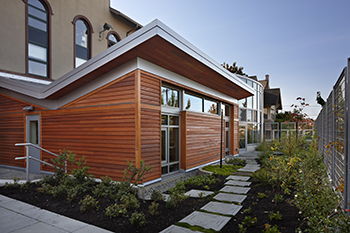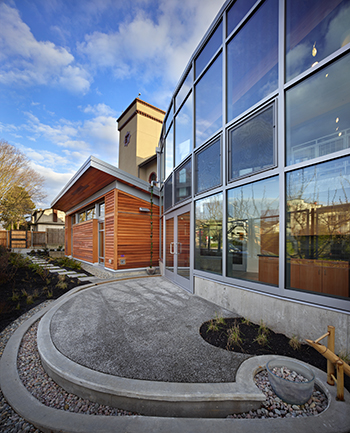Bertschi School Becomes World’s Fourth Living Building
 SEATTLE — Before the Bullitt Center was designed to meet the Living Building Challenge (LBC), the Bertschi School’s Science Wing, also located in Seattle, had already met the same building standards, which required net zero energy, waste and water.
SEATTLE — Before the Bullitt Center was designed to meet the Living Building Challenge (LBC), the Bertschi School’s Science Wing, also located in Seattle, had already met the same building standards, which required net zero energy, waste and water.
In order to be certified as “Living,” the building must perform as designed for one full year of occupancy and pass a third-party audit. Completed in February 2011, the school’s Science Wing has since met the requirements and is now the first Living Building on the West Coast and the world’s fourth.
The idea for the school formed back in 2009 at the Living Future conference. San Francisco-headquartered KMD Architects was inspired by a discussion led by the Living Building Institute and set out to work on a project that met the requirements of the LBC. In conjunction with several other collaborators, they decided to form the Restorative Design Collective, a multi-disciplinary team that contributed pro-bono design services of more than $500,000 in professional time and building materials to the Bertschi School project. One such collaborator was New York-based Skanska USA Building, who provided construction services on the project.
“We looked at it as an opportunity to try and take what we do in every day construction and take it to the next level as it relates to sustainability. That fits with our core values as a green builder, and we wanted to be the first,” said Chris Toher, executive vice president and general manager at Skanska.
The 3,380-square-foot Science Wing was built with significant teacher and student input and allows for student participation through real-time monitoring of the building’s energy and water use so that the students (ages five to 11) can better understand sustainable practices and see how it can impact their daily choices. During construction, the school also hosted a series of assemblies in which the project team would discuss the on-site activities.
The sustainable features include net zero energy and water, a 20-kilowatt photovoltaic system that provides all the building’s required electricity and cisterns that collect rainwater to use for irrigation and flushing of the composting toilet. A green roof and an interior living wall of tropical plants also help save water and treat the building’s grey water.
The interactive learning environment also includes an ethnobotanical garden, which serves as an outdoor classroom. Students can learn about native culture and history from the indigenous northwest plants grown in the garden. These plants are also used in art classes; for example, they can use berries for paint dyes and grasses to create paintbrushes. There is also food produced in the garden and in the neighboring vegetable garden, which teaches students about organic farming and growing food.
 Perhaps the greatest challenge on the project, according to Toher, was finding the appropriate materials that met LBC requirements and working with the material suppliers to understand those requirements.
Perhaps the greatest challenge on the project, according to Toher, was finding the appropriate materials that met LBC requirements and working with the material suppliers to understand those requirements.
“The majority of the material suppliers were not ready for it and were less inclined to give us the specific product information,” Toher said. “Even if they weren’t presenting their product as green, once you divulge that maybe their product is made of red-listed materials, it’s considered not green. It really presented some interesting challenges with us getting all of the materials sourced locally and getting through all the paperwork challenges. That took way more time than we had ever imagined, and we had six people working on it.”
There are also some common practices in the construction industry that were forbidden, which also made construction difficult. For example, duct tape — a typical material used on construction sites — was not allowed anywhere on site even if it wasn’t a part of the finish product, Toher said.
“The thing I took away from the project is that you have to continue to push the industry,” Toher said. “The easy thing to do is to sit back and say, ‘We can’t.’ People have to continue to try to come up with solutions that are economically viable for applications on different types of projects. It happens by people doing it — finding out where the challenges are and finding solutions to those challenges and continuing to answer that call.”
